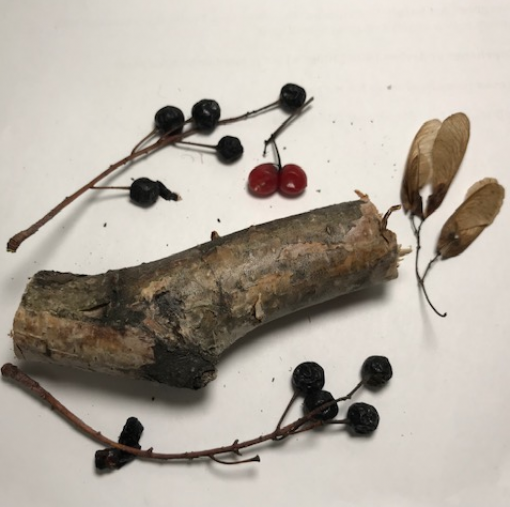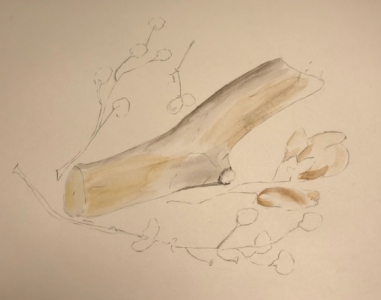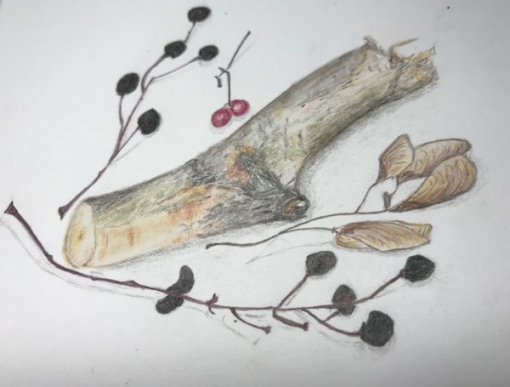I have a book about nature journaling, full of enticing examples of hand-written notes, illustrated by simple, charming line drawings delicately accented with watercolors. The idea of keeping a nature journal appeals to me as a gardener of both cultivated and feral plants; in my mind I can see a garden journal of my endeavors magically appearing on the dining room table (which usually functions more as a desk than a table).
But there is no such journal, the reason being that drawing is a mystery to me, an intimidating activity engaged in by talented people who see things differently than I (being more aurally than visually oriented) do. Nevertheless, the allure of the nature journaling book inspired me to sign up for a weekend workshop in Botanical Art, called The Colors of Winter.
Taught by Fairbanks artist and educator Karen Stomberg, the class was warm, welcoming and accessible to students of many levels and abilities. Karen brought in an array of colored pencils, and an assortment of ‘winter topics’ – short sections of small birch branches, bunches of cranberries and chokecherries, sprays of evergreen boughs, rose hips, and more. Students brought their own small desk lamps for illumination, sketch books, and whatever other supplies they had on hand. Class was held in a large, bright lab room in the Margaret Murie building on the UAF West Ridge campus, which has amazing views: At eleven am we headed en masse to the lovely sitting area to take pictures of the sunrise over the eastern Alaska Range, and at 3 pm we did the same to take pictures of the sun setting in Denali’s shadow.
First, we picked out our ‘winter topic’ materials and then made pencil sketches of them.

This was not as scary as it seemed: it helped that the lines were simple to follow, and Karen had thoughtfully provided small, clear rulers to help us measure our samples and mark out our paper accordingly. I was happily surprised at how my drawing turned out, first sketching lightly and then carefully darkening the lines for the next step, which was to use a light table to transfer the sketch to watercolor paper
Then we used watercolor pencils to lay in some color and give us a sort of ‘road map’ to follow later. This was fun! Rather than use the watercolor pencils directly on the paper, we created ‘palettes’ by scribbling small patches of different colors onto a piece of water-proof paper.
Then, using a small brush and a very little bit of water, we could blend different scribbles and ‘wash’ them on to the watercolor paper. Because the colors were very light, I wasn’t scared of ruining anything; unlike the few rather unfortunate experiences I’ve had with ‘real’ watercolors, everything stayed very contained and controlled.

After the watercolor ‘wash’ dried, then it was time to start layering in texture and value with colored pencils. The recommended pencils, and those supplied by Karen, were
Faber-Castell Polychromos pencils. These are oil-based pigments which provide very clear colors while also blending well. Expensive but a good investment as they are user-friendly, will last a long time and do create authentic effects.
The final steps are to ‘burnish’ the colors by going over them with a white or ivory colored pencil, which helps to coalesce the layers of color and gives them a sort of sheen, and to lightly pencil in shading to enhance the illusion of depth. This last step sounds simple but is quite challenging, it’s important to keep the shading subtle and soft, as it’s much easier to darken a bit if desired, rather than lighten overdone shadows.

Some of the class participants created amazingly realistic pictures of their topics, a painstaking process requiring a lot of focus and detail. My final results were much less precise, but as a newbie and self-defined ‘non artist’, I was pleased with my efforts. The ‘Colors of Winter’ are subtle and lovely and exploring them on a chilly weekend in Fairbanks, with the lovely ‘alpenglow’ sun of midwinter lighting the snow and frosty trees in warm tones of rose and apricot, was a happy way to welcome the New Year. Sketching and coloring plant materials is a natural attraction for gardeners, and I’m looking forward to revisiting my nature journal book with an eye towards creating my own garden journal, using the confidence and skills gained in Karen’s class.

